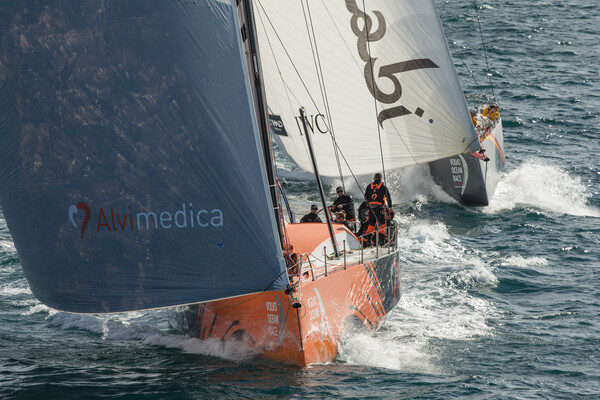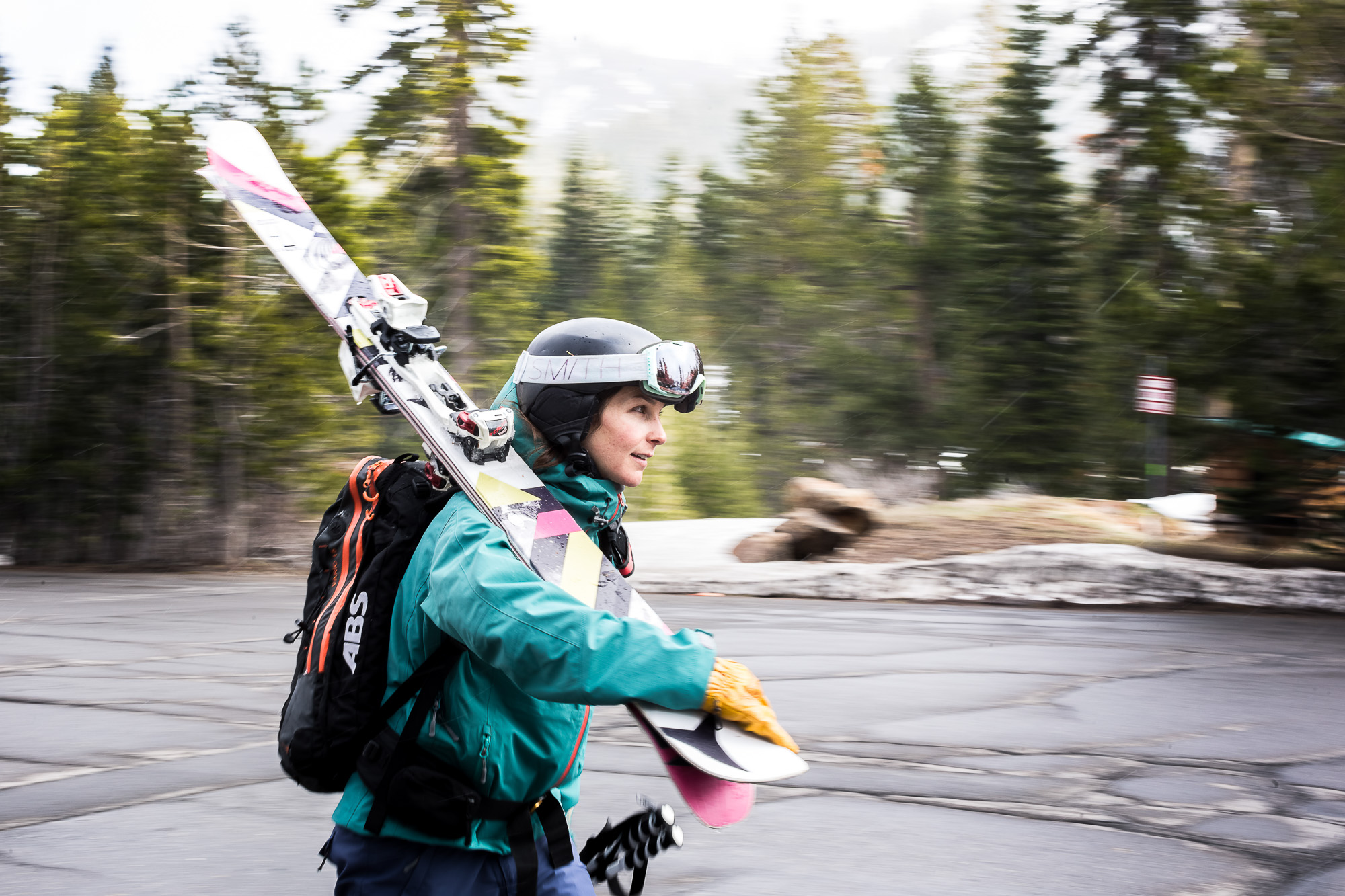Every few years since its inception in 1973, The Ocean Race, formerly known as the Whitbread Round the World Race or the Volvo Ocean Race, has pitted teams of offshore sailors and their supercharged racing boats in a race around the globe. The race takes place in a number of stages, asking teams to navigate the doldrums of the South Atlantic and wrestle the Southern Ocean between New Zealand and Cape Horn. Since The Ocean Race’s inception, competitors have captured some style of video or imagery of the racing and written about their journeys. However, it wasn’t until the 2008-2009 edition of the race that there was a crew member solely dedicated to documenting the stories of their team.
Amory Ross, current Content Director and Media Crewmember for the 11th Hour Racing Team, heard about the development of the media crewmember (MCM) role for the 2008 edition of the race and knew he had to be on a team when the next fleet crossed the starting line in 2011. Two years out of college and just starting work as a sailing photographer, Ross knew he would need to sharpen his skills in writing and video to make the best possible case for becoming an onboard reporter (OBR). His opportunity came aboard Ken Read’s PUMA in 2011.

When I sat down with Ross over Zoom, he had just returned to Newport, Rhode Island from a long weekend of ski touring and had just uploaded a picture to Instagram from the cockpit of a Cessna 152 (he’s working toward a pilot’s license). Ross and Charlie Enright, the 11th Hour Racing Team Skipper, had been grounded in the states due to COVID-19 travel restrictions and unable to return to France, where their team’s second IMOCA 60 is currently being assembled. Ross told me the story of how he found his way to shooting sailing photography, how he landed his dream job in the Ocean Race and what the next edition of the race holds for him.
*The following interview had been edited for length and content.*
When did the OBR ambition start for you?
Sailing was something that I always knew I enjoyed but I never quite planned on making it a career or anything like that. I double majored in economics and public policy. I guess it was my senior year, I sort of pulled the ripcord and bailed on that trajectory knowing that if I had an opportunity to try something different, that was the time to do it. I could always go back to a finance job in five years. So, I rented a camera and went to Key West Race Week, which used to be the biggest wintertime regatta in the States. I took a lot of photos down there and ended up selling a bunch and came back to school feeling like I had a sense for composition and all the basic fundamentals of photography. Combining that with my budding enthusiasm for sailing and the ocean, [I figured] it probably deserved a try.
So, you find yourself living in Newport, Rhode Island after college, shooting sailing as much as possible and then the Volvo Ocean Race adds the media crew member role in 2008. Do the gears start to turn?
When the OBR job came around, you needed to be a writer and familiar with video. It’s like the whole multimedia package—you’re writing, taking photos, shooting video, editing video, and also living and existing on these boats. I knew pretty quickly that it was what I wanted to do.
I was lucky that photography put me in touch with a lot of those people that were in a position to help me get there. I set my sights on the 2011-2012 Volvo Ocean Race. I knew the guy that was running [PUMA], and just relentlessly chirped his ear about an opportunity and what I needed to boost my profile. A lot of that was really just sailing, and proving that you’re not a liability on these boats and you have more to add other than just a sharp eye or good editing skill. You have to be able to survive and exist and you have to be able to fit inside the team, there’s a chemistry involved. I knew I had all those things; I love being parts of teams and sport in general, so it was really just about working on the skillset, getting it to a point where I made it really hard for Kenny [Ken Read] to say no.

Once you made the team, how does the job start to take shape? Could you describe a day in the life of an OBR?
Day to day is very repetitive but also very different—it’s completely dependent on the conditions and the circumstances of the race. From an equipment standpoint, every boat has a satellite dome on the back provided by Inmarsat—all of your content gets sent through that. Back in Alicante, Spain at the race headquarters, a whole team of people are waiting to pull all that stuff off the server and start pushing it out. Your team has access to that as well. That’s the easy part.
You’d be amazed at how reliable these systems are. Still, it takes a while. We’re sending HD video, 1080 resolution video—up to six or seven minutes of it—and then all of the photos that go with it. There’s a lot of content being transmitted. It may take 45 minutes to send a video. I think over the course of three races I can only really remember a few spots where you’re crossing between satellites. The Inmarsat system uses satellites called geo-stationary satellites that kind of rotate with the Earth in its lowest orbit. Occasionally, you’re transitioning between one satellite and the other and there’s a hole or a blank area, but other than that it always works.
That’s kind of the easy part. The hard part is filming and shooting onboard and then sitting down to edit it at the desk. Sometimes a story falls in your lap. There might be a whale that you see or something cool that you get on a drone, and that becomes a story, and then you’ve got the footage and you just need two interviews and you’re done. In 15 minutes, you have the whole story for the day. Relative to other stories, those can be really easy to film. Sometimes, you’re trying to tell a story of the day in the life of somebody and that’s a 24-hour video where you’re trying to capture the whole routine of waking up at midnight and going on your first watch and then all the way through until midnight the next day.
All of a sudden you find yourself sitting down to edit a feature film and the boat’s slamming around and it’s really hot or it’s really cold and you’ve got water dripping on you and it takes you a while to edit. Maybe you’re not feeling well, or maybe, all of a sudden, it’s time to go make food. Things can get pretty jumbled pretty quickly.

In moments when the race isn’t going so well aboard, moments where the race is taking a turn for the worse for the team, how do you pull the story out of the team and share their experience?
For me, I always want to feel like if I have a tough question for somebody, if I really need an answer to something and know that whoever I’m going to ask probably doesn’t want to answer it, I want to make it impossible for them to turn me away. Your work ethic, doing things like making the food and keeping the boat dry and just always being there to help with things that you can help with, it does give you a bit of currency to do your other job. There’s a two-way transaction. I will work my ass off for you guys if you in turn respect that I have a job to do and that I have my own journalistic integrity that needs to be observed.
You talked about doing work outside of holding the camera so that asking the hard questions is easier. What else might you be doing day-to-day during the race?
I think there are a lot of other ways to impact the performance of the boat. Your attitude, being positive, making a round of coffees, taking care of the food which is one thing that maybe a media guy on another boat isn’t doing that the team has to do. Bailing the boat out, really working hard for that kind of stuff. It’s technically not “performance-enhancing,” but you’re alleviating a responsibility of a sailor and you’re also earning goodwill and making them respect and trust you.
For the next race, 11th Hour has decided to take on the challenge of taming an IMOCA 60. These boats are new for your team; they’re notoriously cramped but blisteringly quick, even more so with the addition of foils. Not to mention they’re meant for one person, not five. What will all of these changes mean for you?
They’re pretty cool boats. For sailing, foiling is everything right now. We’re seeing this huge evolution in offshore sailing from big powerful boats that were kind of like your V8, now, down to these small, light, nimble foiling boats that are more like an Indy Car. You just have to be far more respectful of their tendencies and fragilities. Most of what we’re going to be doing now will be wireless. Editing on an iPad because you can’t have a keyboard with vulnerabilities, water, and other stuff getting in there. You can’t have cables the way these boats are slamming around. Everything is going to be wireless.
There’s also probably going to be more emphasis on sending stuff for somebody else to edit. You can’t do anything on these boats. But in a lot of ways, that is the story. Just learning to manage life onboard and to continue pushing even as the circumstances onboard have changed. You look at social media and all these different outlets and avenues to tell stories and it’s just such an interesting time to be a part of it. It’s always changing.



